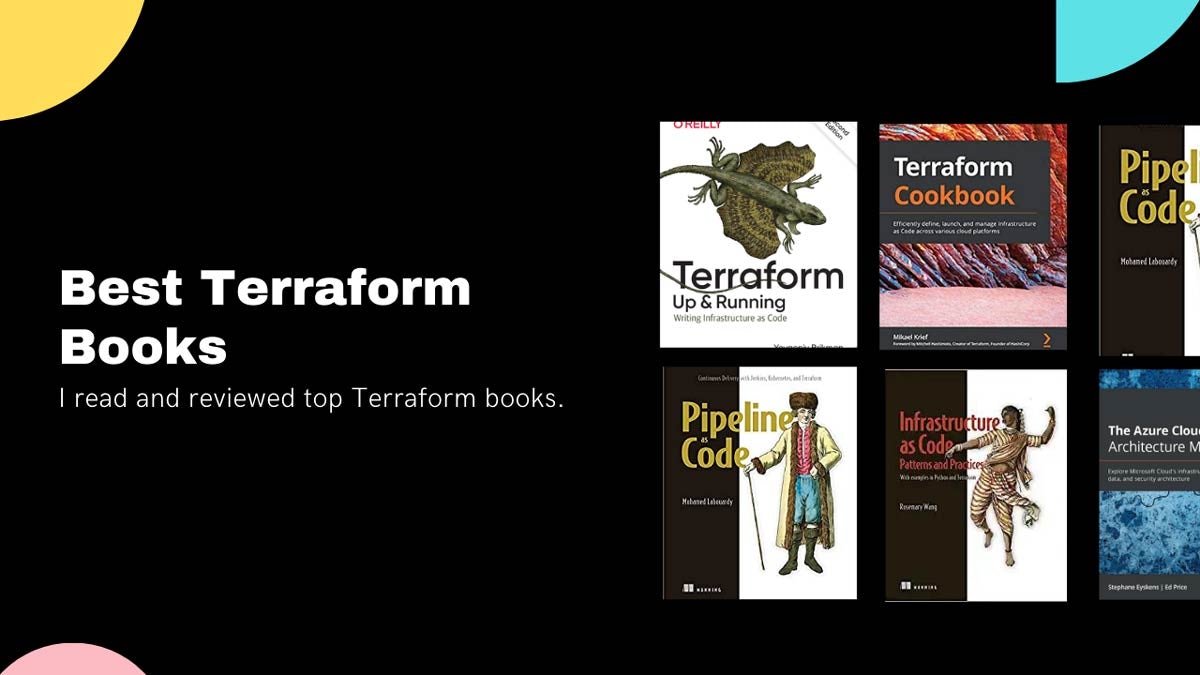5 Best Terraform Books in 2023
Most popular
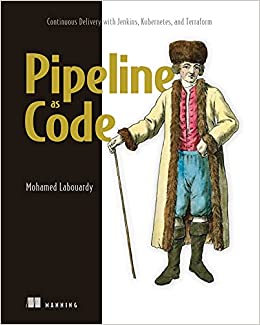
- Learn the basics of Terraform
- Learn the basics of Jenkins
- Learn how to use Jenkins for code-driven CI/CD pipelines
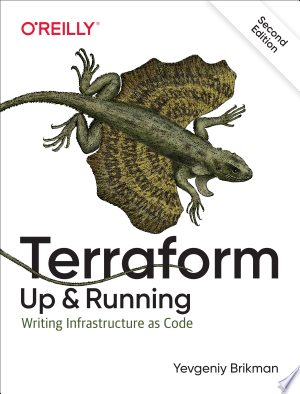
- Understand the basics of Terraform
- Learn how to write production-grade Terraform code
- Compare Terraform to other popular DevOps tools
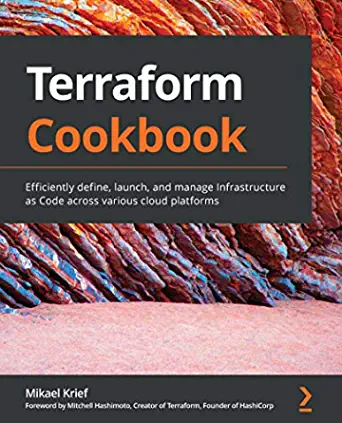
- Continuous integration and continuous delivery (CI/CD)
- Zero-downtime deployments
- Infrastructure as Code (IaC)
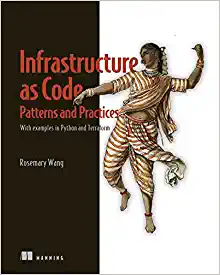
- Learn how to use Terraform to provision servers and services
- Understand the benefits of Infrastructure as Code
- Learn about patterns for scaling systems
Terraform is a tool for building, changing, and versioning infrastructure safely and efficiently. Terraform can manage existing and popular service providers and custom in-house solutions.
With Terraform, you can describe your entire infrastructure in code, even as it changes. This allows you to predict exactly what Terraform will build, change, and destroy before ever running a single line of code.
If you want to learn how to use Terraform, these are some of the best books on the subject. They can help you with best practices and also prepare you for Terraform interview questions.
Best Terraform books are:
1. Pipeline as Code : Continuous Delivery with Jenkins, Kubernetes, and Terraform

Pipeline as Code is a practical guide to automating your development pipeline in a cloud-native, service-driven world.
You’ll use the latest infrastructure-as-code tools like Packer and Terraform to develop reliable CI/CD pipelines for numerous cloud-native applications.
Follow this book's insightful best practices, and you’ll soon be delivering software that’s quicker to market, faster to deploy, and with less last-minute production bugs.
Pipeline as Code shows you how to build reliable CI/CD pipelines for cloud-native applications using Jenkins, Docker, Terraform, and other modern tools.
You'll learn how to use code to manage all aspects of your pipeline, making it easier to use and maintain. With this book's hands-on examples, you'll be able to quickly create efficient pipelines for microservices, serverless functions, and more.
If you're a developer familiar with Jenkins and Docker, this book is for you. No prior experience with CI/CD or DevOps is necessary.
Authors: Mohamed Labouardy
Get the bookTopics covered
You will learn how to:
- Learn the basics of Terraform
- Learn the basics of Jenkins
- Learn how to use Jenkins for code-driven CI/CD pipelines
- Master the usage of Terraform for code-based infrastructure management
- Understand the principles of a successful DevOps culture
Mohamed Labouardy: About the author
Mohamed Labouardy is a CTO and Co-Founder of Crew.work. He is also the Founder of Komiser.io, and is a DevSecOps Evangelist. Labouardy is an author and speaker, and is dedicated to helping others learn about the benefits of DevOps culture and practices.
2. Terraform: Up & Running : Writing Infrastructure as Code

This hands-on book written by Yevgeniy (Jim) Brikman (cofounder of Gruntwork) shows you how to get up and running with Terraform fast.
Terraform has quickly become a key player in the DevOps world for defining, launching, and managing infrastructure as code (IaC) across a variety of cloud and virtualization platforms.
In Terraform: Up & Running, you will learn how to write production-grade Terraform modules and dive into manual and automated testing for your code.
With this book, you'll also compare Terraform to Chef, Puppet, Ansible, CloudFormation, and Salt Stack.
Finally, you'll deploy server clusters, load balancers, and databases with Terraform.
If you’re looking for a comprehensive guide to Terraform—one that will show you how to deploy and manage infrastructure with this powerful tool—you’ve come to the right place.
This book is your ideal companion, whether you’re a sysadmin, DevOps engineer, or new developer. Brikman walks you through code examples that demonstrate Terraform’s simple, declarative programming language for deploying and managing infrastructure with a few commands. Veteran sysadmins, DevOps engineers, and novice developers will quickly go from Terraform basics to running a full stack application.
Authors: Yevgeniy Brikman
Get the bookTopics covered
You will learn how to:
- Understand the basics of Terraform
- Learn how to write production-grade Terraform code
- Compare Terraform to other popular DevOps tools
- Deploy server clusters, load balancers, and databases with Terraform
- Create reusable infrastructure with Terraform modules
3. Terraform Cookbook : Efficiently define, launch, and manage Infrastructure as Code across various cloud platforms

The Terraform Cookbook is a guide for managing and scaling your infrastructure using Infrastructure as Code (IaC) with Terraform.
The book starts with recipes for setting up the environment, gradually guides you in configuring, provisioning, collaborating, and building a multi-environment architecture.
You'll also explore recipes for Azure Template, Azure CLI, Terraform configuration, and Terragrunt.
Finally, you'll explore the latest DevOps trends such as continuous integration and continuous delivery (CI/CD) and zero-downtime deployments.
With The Terraform Cookbook, you'll develop the skills you need to get the most value out of Terraform and manage your infrastructure effectively.
The second edition of The Terraform Cookbook includes three new chapters: Collaborating with Others, Testing Your Configuration, and Extending Terraform.
These new chapters provide recipes for working with Terraform in a team environment, testing your configuration before deployment, and extending Terraform with custom providers and modules.
If you're a developer, operator, or DevOps engineer looking to use Infrastructure as Code, then this book is for you. Some experience with Microsoft Azure, Jenkins, shell scripting, and DevOps practices is required.
Authors: Mikael Krief, Mitchell Hashimoto
Get the bookTopics covered
You will learn how to:
- Continuous integration and continuous delivery (CI/CD)
- Zero-downtime deployments
- Infrastructure as Code (IaC)
- Configuration management
Mikael Krief: About the author
Mikael Krief is a software engineer and author. He is the author of the books "Mastering Terraform" and "HashiCorp Configuration Management." Krief is a frequent speaker at conferences and user groups, where he shares his insights on Terraform, configuration management, and DevOps. He is also active in the open source community, contributing to projects such as Terraform and Packer.
4. Patterns and Practices for Infrastructure as Code : With examples in Python and Terraform

If you want to get up and running with Terraform as quickly as possible, this is the book for you.
It starts with a quick-start guide for those who just want to see how Terraform works without all the details.
Next, it shows you how to use Terraform's many features to manage infrastructure at scale.
Finally, it dives into advanced topics such as working with modules, state management, and collaborating on Terraform configurations with other people.
The book is full of examples in Python and Terraform. So if you are new to Python, pair this book with a python book for better understanding.
Authors: Rosemary Wang
Get the bookTopics covered
You will learn how to:
- Learn how to use Terraform to provision servers and services
- Understand the benefits of Infrastructure as Code
- Learn about patterns for scaling systems
- Automate software infrastructure by capturing configurations as scripts
- Follow easy-to-understand examples in Python and Terraform
5. The Azure Cloud Native Architecture Mapbook : Explore Microsoft Cloud’s infrastructure, application, data, and security architecture
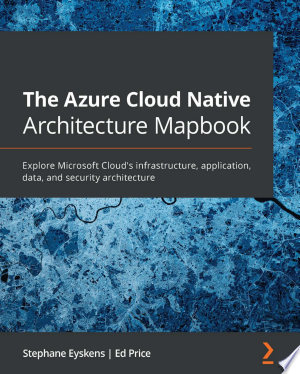
The Azure Cloud Native Architecture Mapbook will help you to understand Azure and choose the best solutions for your unique requirements.
The book starts with the key aspects of architecture and shows you how to map different architectural perspectives.
You'll get acquainted with the basic cloud vocabulary and learn which strategic aspects to consider for a successful cloud journey.
As you advance through the chapters, you'll understand technical considerations from the perspective of a solutions architect.
You'll then explore infrastructure aspects, such as network, disaster recovery, and high availability, and leverage Infrastructure as Code (IaC) through ARM templates, Bicep, and Terraform.
The book also guides you through cloud design patterns, distributed architecture, and ecosystem solutions.
By the end of this book, you'll have picked up best practices and more rounded knowledge of the different architectural perspectives.
Authors: Stephane Eyskens, Ed Price
Get the bookTopics covered
You will learn how to:
- Understand the key aspects of architecture
- Map different architectural perspectives
- Consider strategic aspects for a successful cloud journey
- Understand technical considerations from the perspective of a solutions architect
- Explore infrastructure aspects such as network, disaster recovery, and high availability
- Leverage Infrastructure as Code (IaC) through ARM templates, Bicep, and Terraform
- Work with both traditional (ETL and OLAP) and modern data practices (big data and advanced analytics) in the cloud
- Get to grips with cloud native security
FAQ
What is Terraform?
Terraform is a tool for building, changing, and versioning infrastructure safely and efficiently. Terraform can manage existing and popular service providers as well as custom in-house solutions.
Configuration management tools such as Chef, Puppet, Ansible, and SaltStack typically focus on tightly-knit infrastructure components such as packages, files, and services. Terraform, on the other hand, is more declarative and focuses on resources or "things" that exist in your infrastructure. This difference is important because it enables Terraform to represent all aspects of almost any infrastructure type, from physical and virtual servers to email and DNS providers.
Is Terraform an automation tool?
Terraform is automation tool because it can automate the provisioning and management of infrastructure resources. The most common way to automate the provisioning and management of infrastructure resources is using pipelines.
What is the difference between Terraform and Kubernetes?
The main difference between Terraform and Kubernetes is that Terraform is used to manage infrastructure resources while Kubernetes is used to containerize and orchestrate applications.
If you want to learn more about Kubernetes, check out my list of best Kubernetes books.
Josip Miskovic is a software developer at Americaneagle.com. Josip has 10+ years in experience in developing web applications, mobile apps, and games.
Read more posts →Last modified on:
- 1. Pipeline as Code : Continuous Delivery with Jenkins, Kubernetes, and Terraform
- 2. Terraform: Up & Running : Writing Infrastructure as Code
- 3. Terraform Cookbook : Efficiently define, launch, and manage Infrastructure as Code across various cloud platforms
- 4. Patterns and Practices for Infrastructure as Code : With examples in Python and Terraform
- 5. The Azure Cloud Native Architecture Mapbook : Explore Microsoft Cloud’s infrastructure, application, data, and security architecture
- FAQ

I've used these principles to increase my earnings by 63% in two years. So can you.
Dive into my 7 actionable steps to elevate your career.
Related Posts
- Best Web Development Books
- Best Software Testing Books
- Best Git Books
- Best SQL Books
- Best React Books
- Best GraphQL Books
- Best C# Books
- Best Python Books
- Best Terraform Books
- Best Node.js Books
- Best Rust Books
- Best REST API Books
- Best Unit Testing Books
- Best TypeScript Books
- Best Cryptography Books
- Best Kubernetes Books
- Best Next.js Books
- Best Kotlin Books
- Best Ethical Hacking Books
- Best Cloud Computing Books
